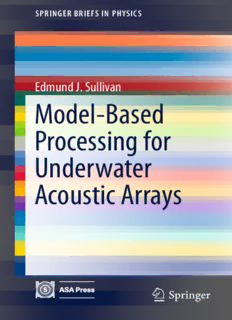Table Of ContentSPRINGER BRIEFS IN PHYSICS
Edmund J. Sullivan
Model-Based
Processing for
Underwater
Acoustic Arrays
123
SpringerBriefs in Physics
EditorialBoard
EgorBabaev,UniversityofMassachusetts,USA
MalcolmBremer,UniversityofBristol,UK
XavierCalmet,UniversityofSussex,UK
FrancescaDiLodovico,QueenMaryUniversityofLondon,UK
MaartenHoogerland,UniversityofAuckland,NewZealand
EricLeRu,VictoriaUniversityofWellington,NewZealand
JamesOverduin,TowsonUniversity,USA
VesselinPetkov,ConcordiaUniversity,Canada
CharlesH.-T.Wang,UniversityofAberdeen,UK
AndrewWhitaker,Queen’sUniversityBelfast,UK
Moreinformationaboutthisseriesathttp://www.springer.com/series/8902
Edmund J. Sullivan
Model-Based Processing
for Underwater Acoustic
Arrays
123
EdmundJ.Sullivan
Portsmouth,RI,USA
ISSN2191-5423 ISSN2191-5431 (electronic)
SpringerBriefsinPhysics
ISBN978-3-319-17556-0 ISBN978-3-319-17557-7 (eBook)
DOI10.1007/978-3-319-17557-7
LibraryofCongressControlNumber:2015938454
SpringerChamHeidelbergNewYorkDordrechtLondon
©EdmundJ.Sullivan2015
Thisworkissubjecttocopyright.AllrightsarereservedbythePublisher,whetherthewholeorpartof
thematerialisconcerned,specificallytherightsoftranslation,reprinting,reuseofillustrations,recitation,
broadcasting,reproductiononmicrofilmsorinanyotherphysicalway,andtransmissionorinformation
storageandretrieval,electronicadaptation,computersoftware,orbysimilarordissimilarmethodology
nowknownorhereafterdeveloped.
Theuseofgeneraldescriptivenames,registerednames,trademarks,servicemarks,etc.inthispublication
doesnotimply,evenintheabsenceofaspecificstatement,thatsuchnamesareexemptfromtherelevant
protectivelawsandregulationsandthereforefreeforgeneraluse.
Thepublisher,theauthorsandtheeditorsaresafetoassumethattheadviceandinformationinthisbook
arebelievedtobetrueandaccurateatthedateofpublication.Neitherthepublishernortheauthorsor
theeditorsgiveawarranty,expressorimplied,withrespecttothematerialcontainedhereinorforany
errorsoromissionsthatmayhavebeenmade.
Printedonacid-freepaper
SpringerInternational PublishingAGSwitzerlandispartofSpringerScience+Business Media(www.
springer.com)
To Lori,who leftus fartoosoon
Preface
This monograph presents a reasonably complete treatment of the model-based
approachto the processing of data from underwater acoustic arrays. By complete
wemeanthatthematerialhereinisaccessibletoanyoneatthelevelofabachelor’s
degree in engineering, but may not be sufficiently familiar with the areas of
statisticalsignalprocessingoracousticarrayprocessing.Withthisgoalinmind,it
providesareasonablyrigoroustreatmentofstandardtime-domainstatisticalsignal
processingandacousticarrayprocessingwithanemphasisonitsspatialprocessing
aspects. A second reason for taking this approach is that since the processing
philosophypresentedheredifferssufficientlyfromthestandardapproach,areview
ofthestandardapproachwaswarranted.
At its heart, model-based processing as discussed here is a form of Bayesian
processingthatreliesheavilyonphysicalmodelstoprovidetheaprioriinformation.
ThisisdonewithintheframeworkoftheKalmanfilter,sinceititselfisaBayesian
processor, and additionally provides a natural framework for including physical
models, along with the ability of including prior information in a statistical form
as in the usual Bayesian processor. Further, it is capable of easily handling the
nonlinearitiesthataccompanyreal-worldmodels.Byphysicalmodelswemeanhere
such phenomenaas array motion, array configuration,signalstructures other than
planewavemodels,andoceanicpropagationmodels.Becauseofthis,thematerial
presentedhereconstitutesanapproachtoacousticarrayprocessingthatiscapable
ofprovidingperformanceimprovementovermanyofthepresentlyusedmethods.
I wouldlike toacknowledgeDr. JamesCandy,Chief ScientistforEngineering,
the LawrenceLivermoreNationalLaboratoryfor originallyintroducingme to the
Kalmanfilterandemphasizingitsapplicabilityfarbeyonditsoriginalareaofcontrol
theory.Hemadeitclearthatitprovidesaframeworkforperformanceenhancement
to the field of signal processing and estimation theory in a very general way. I
also gratefully acknowledge Dr. Allan Pierce, Professor Emeritus of Mechanical
Engineering,BostonUniversity,whoencouragedmetowritethisbook.
Portsmouth,RI,USA EdmundJ.Sullivan
December2014
vii
Contents
1 Introduction .................................................................. 1
1.1 Background.............................................................. 1
1.2 TheInverseProblem.................................................... 1
1.3 Model-BasedProcessing................................................ 4
1.4 Observability............................................................ 6
1.5 BookOutline............................................................ 7
References..................................................................... 7
2 TheAcousticArray ......................................................... 9
2.1 TheAcousticArray..................................................... 9
2.2 TheLineArray.......................................................... 10
2.3 Beamforming............................................................ 13
2.3.1 DelayandSumBeamforming.................................. 13
2.3.2 PhaseShiftBeamformingandthek(cid:2)! Beamformer........ 14
2.3.3 BeamPatterns................................................... 16
2.4 ArrayGainandtheDirectivityIndex .................................. 17
2.4.1 LimitationsoftheDirectivityIndex ........................... 20
2.5 ArrayOptimization ..................................................... 21
2.6 BearingEstimation...................................................... 22
2.7 Three-DimensionalArrays ............................................. 23
References..................................................................... 25
3 StatisticalSignalProcessingOverview .................................... 27
3.1 Introduction ............................................................. 27
3.2 DetectionTheoryforTotallyKnownSignals.......................... 27
3.3 ClassicalEstimationTheory............................................ 30
3.4 TheCramér–RaoLowerBound........................................ 31
3.5 EstimatorStructure...................................................... 33
3.5.1 TheMinimumVarianceUnbiasedEstimator.................. 34
3.5.2 TheNon-whiteMinimumVarianceUnbiasedEstimator ..... 35
3.5.3 BestLinearUnbiasedEstimator ............................... 36
3.5.4 TheMaximumLikelihoodEstimator.......................... 37
ix
Description:This monograph presents a unified approach to model-based processing for underwater acoustic arrays. The use of physical models in passive array processing is not a new idea, but it has been used on a case-by-case basis, and as such, lacks any unifying structure. This work views all such processing

